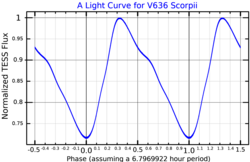| Observation data Epoch J2000 Equinox J2000 | |
|---|---|
| Constellation | Scorpius |
| Right ascension | 17h 22m 46.47796s [2] |
| Declination | −45° 36′ 51.3868″ [2] |
| Apparent magnitude (V) | 6.40 - 6.92 [3] |
| Characteristics | |
| Cepheid | |
| Spectral type | F7/8Ib/II-G5 [3] |
| Variable type | δ Cep [3] |
| companion | |
| Spectral type | B9.5V [4] |
| Astrometry | |
| Radial velocity (Rv) | 9.09 ± 0.17 [5] km/s |
| Proper motion (μ) |
RA: -3.05 ± 1.03
[2]
mas/
yr Dec.: -2.40 ± 0.38 [2] mas/ yr |
| Parallax (π) | 1.15 ± 0.76 mas [2] |
| Distance | approx. 3,000
ly (approx. 900 pc) |
| Absolute magnitude (MV) | -3.64 [4] |
| Orbit | |
| Period (P) | 1,318 days [4] |
| Semi-major axis (a) | 6.7 [4] |
| Eccentricity (e) | 0.26 [6] |
| Details | |
| Cepheid | |
| Mass | 5.6 [4] M☉ |
| Radius | ~50 [7] R☉ |
| Luminosity | 2,500 [4] L☉ |
| Metallicity | +0.07 [8] |
| companion | |
| Mass | 2.4 M☉ |
| Other designations | |
| Database references | |
| SIMBAD | data |
V636 Scorpii is a multiple star system in the constellation Scorpius, 3,000 light years away. The primary is a Classical Cepheid (δ Cephei) variable and its visual magnitude varies from 6.4 to 6.9.
V636 Scorpii is a spectroscopic binary, and the fainter companion is thought to itself consist of two stars. The primary is a luminous yellow star and a δ Cephei variable. The less massive companion orbits every 3.6 years and is apparently a B9.5 main sequence star, but the dynamics of the system suggest that it may actually be a pair of stars is a close orbit. [9]
The Cepheid primary pulsates regularly with a period of 6.79671 days. It is a yellow-white supergiant or bright giant that is 5.6 times as massive as the Sun and 2,500 times as luminous. [4]
References
- ^ "MAST: Barbara A. Mikulski Archive for Space Telescopes". Space Telescope Science Institute. Retrieved 8 December 2021.
- ^ a b c d e Van Leeuwen, F. (2007). "Validation of the new Hipparcos reduction". Astronomy and Astrophysics. 474 (2): 653–664. arXiv: 0708.1752. Bibcode: 2007A&A...474..653V. doi: 10.1051/0004-6361:20078357. S2CID 18759600.
- ^ a b c Samus, N. N.; Durlevich, O. V.; et al. (2009). "VizieR Online Data Catalog: General Catalogue of Variable Stars (Samus+ 2007-2013)". VizieR On-line Data Catalog: B/GCVS. Originally Published in: 2009yCat....102025S. 1. Bibcode: 2009yCat....102025S.
- ^ a b c d e f g Evans, Nancy Remage; Bond, Howard E.; Schaefer, Gail H.; Mason, Brian D.; Karovska, Margarita; Tingle, Evan (2013). "Binary Cepheids: Separations and Mass Ratios in 5M ⊙ Binaries". Astronomical Journal. 146 (4): 93, 10 pp. arXiv: 1307.7123v1. Bibcode: 2013AJ....146...93E. doi: 10.1088/0004-6256/146/4/93. S2CID 34133110.
- ^ Pourbaix, D.; Tokovinin, A. A.; Batten, A. H.; Fekel, F. C.; Hartkopf, W. I.; Levato, H.; Morrell, N. I.; Torres, G.; Udry, S. (2004). "SB9: The ninth catalogue of spectroscopic binary orbits". Astronomy and Astrophysics. 424 (2): 727–732. arXiv: astro-ph/0406573. Bibcode: 2004A&A...424..727P. doi: 10.1051/0004-6361:20041213. S2CID 119387088.
- ^ Evans, Nancy Remage; Carpenter, Kenneth G.; Robinson, Richard; Kienzle, Francesco; Dekas, Anne E. (2005). "High-Mass Triple Systems: The Classical Cepheid Y Carinae". The Astronomical Journal. 130 (2): 789–793. arXiv: astro-ph/0504169. Bibcode: 2005AJ....130..789E. doi: 10.1086/430458. S2CID 119342828.
- ^ Moskalik, P.; Gorynya, N. A. (2005). "Mean Angular Diameters and Angular Diameter Amplitudes of Bright Cepheids". Acta Astronomica. 55: 247. arXiv: astro-ph/0507076. Bibcode: 2005AcA....55..247M.
- ^ Marsakov, V. A.; Koval', V. V.; Kovtyukh, V. V.; Mishenina, T. V. (2013). "Properties of the population of classical Cepheids in the Galaxy". Astronomy Letters. 39 (12): 851. Bibcode: 2013AstL...39..851M. doi: 10.1134/S1063773713120050. S2CID 119788977.
- ^ Böhm-Vitense, E.; Evans, N. R.; Carpenter, K.; Albrow, Michael D.; Cottrell, P. L.; Robinson, R.; Beck-Winchatz, B. (1998). "The Mass of the Cepheid Binary V636 Scorpii". The Astrophysical Journal. 505 (2): 903. Bibcode: 1998ApJ...505..903B. doi: 10.1086/306177. S2CID 122385825.
